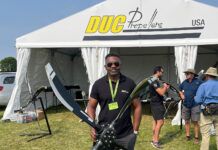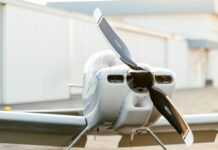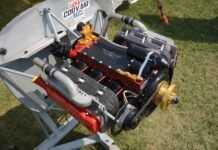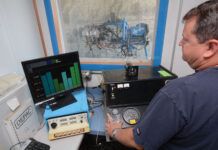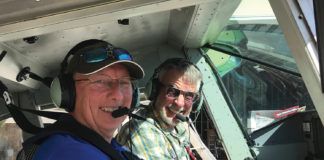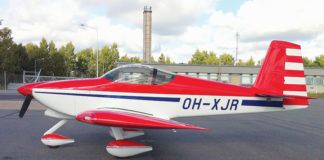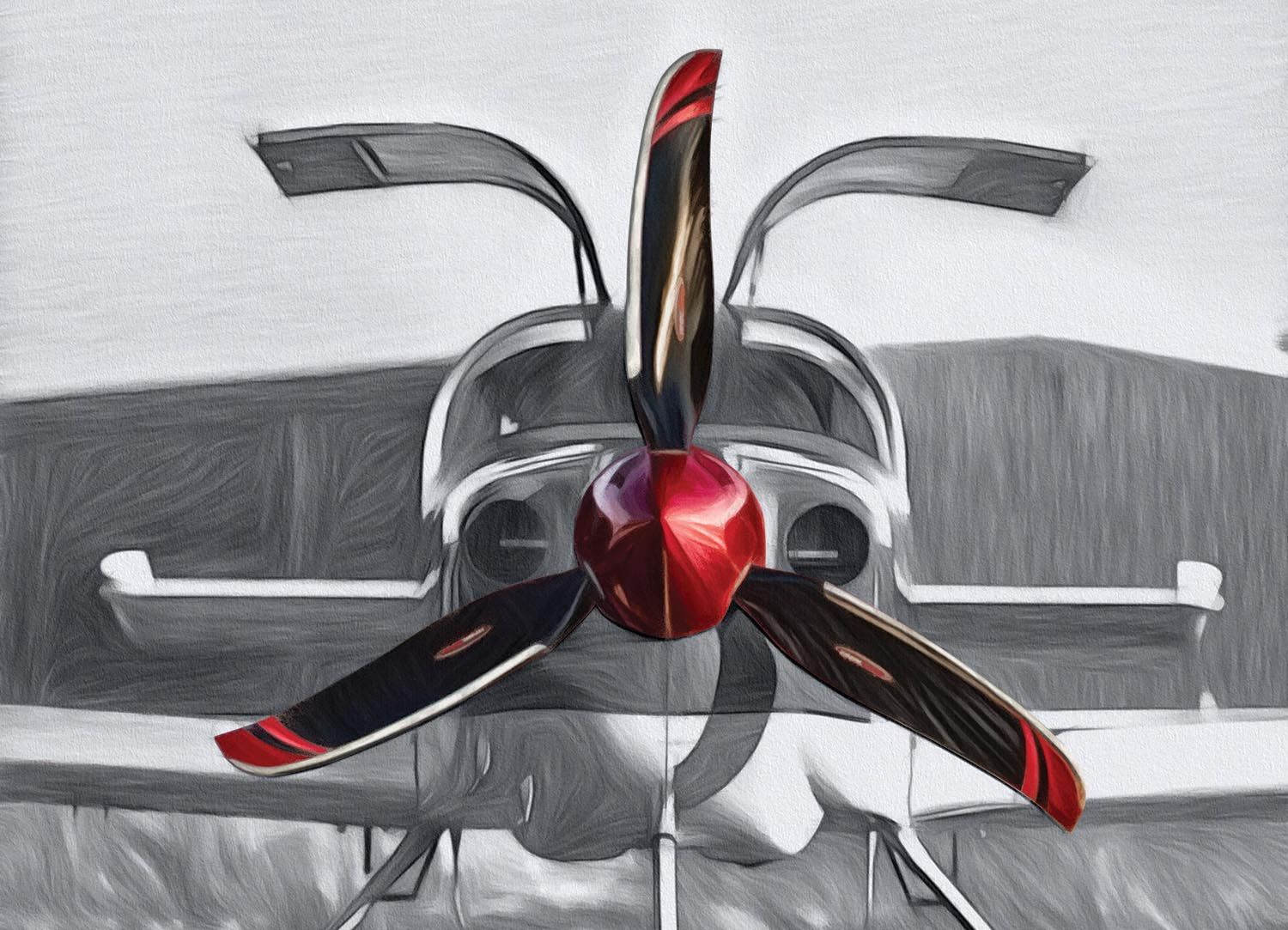 The brothers Wright, arguably the world’s first collaborative airplane homebuilders, were faced with a dilemma when powering their biplane glider. They needed a propeller and, there being no Spruce outlet at the time, were faced with having to make one themselves. In their analytical Midwestern fashion, they started whittling and wound up with a pair of chain-driven airscrews with amazingly adequate efficiency.
The brothers Wright, arguably the world’s first collaborative airplane homebuilders, were faced with a dilemma when powering their biplane glider. They needed a propeller and, there being no Spruce outlet at the time, were faced with having to make one themselves. In their analytical Midwestern fashion, they started whittling and wound up with a pair of chain-driven airscrews with amazingly adequate efficiency.
We have it much easier today. There are any number of certified and Experimental aircraft propellers available to us, and long-established manufacturers will be ready to serve our needs. The art of propeller making is alive and well in the jet age.
Choosing the right prop to go with your homebuilt’s engine has significant impact on the aircraft’s performance, probably second only to the powerplant selection. The designer’s recommendation bears weight here, since there has probably been empirical experimentation done in the past. There’s nothing wrong with beginning with a conservative approach. You can always bolt on a different propeller once initial test flying is complete.
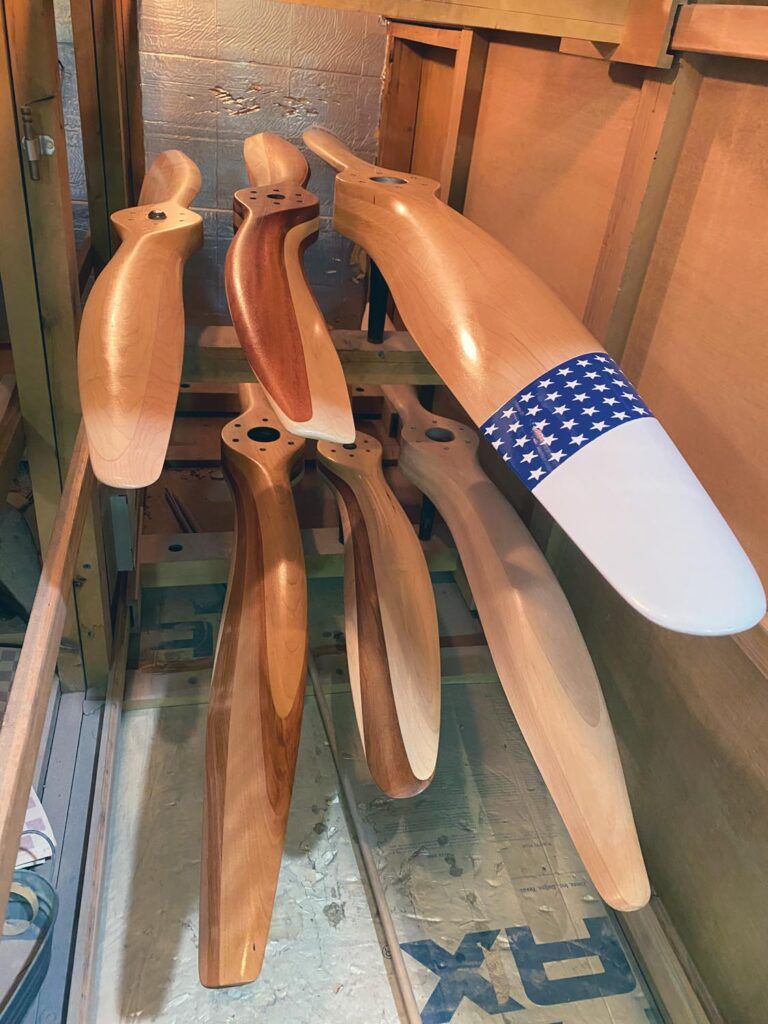
Prop Types
The category of propeller, and the suppliers offering it, can set the tone for your search. At the top of the technological heap are constant-speed controllable props, governed by pitch-changing mechanisms that automatically hold a selected rpm throughout airspeed and maneuvering variances. Set-it-and-forget-it is a wonderful work-saver for the pilot and allows engine power to be directed into whatever mode of flight is desired—takeoff, cruise climb or economy endurance.
Simpler in-flight adjustable propellers, by comparison, are devoid of governing but still offer the ability to rev up for takeoff and manage pitch in cruise by allowing manual adjustment of rpm, usually with an electric motor moving the blade angle. Once set, engine speed will vary with airspeed changes in turbulent air, so some throttle jockeying during cruise may be needed.
Even less complex are ground-adjustable propellers, with each blade clamped into a hub that allows rotation to optimize thrust at a fixed-pitch setting. Too much pitch and the engine may not develop enough power to get off the ground. Too little pitch, on the other hand, can allow the engine to flail away at high rpm in cruise unless the throttle is pulled back. With experimentation, one can find the best compromise pitch for a given airplane/engine combination.
At the base of the propeller-choice table is a fixed-pitch prop, made to satisfy most, but not all, performance targets. Because airplanes spend most of their time in cruising flight, a fixed-pitch propeller is usually constructed to allow the engine to put adequate power into level flight, accepting a penalty in takeoff acceleration.
Budgetary constraints, and sometimes engine type, dictate what category of propeller you can have. Constant-speed propellers weigh more, cost more and need periodic maintenance. If your engine isn’t set up to deliver pressurized oil to a hydraulic constant-speed prop, you’ll either have to accept electric pitch control, ground-adjustable blades or a fixed-pitch prop.
Lots of Choices
In the unfettered world of Experimental aviation, we have the ability to choose from a variety of non-certificated propellers, perhaps one custom-made to our exact specifications. Owners of type-certificated airplanes, by comparison, are limited to propellers called out in the certification paperwork or aftermarket props STC’d for installation on their aircraft. For Experimental use the propeller manufacturer need not pursue certification, thereby saving the cost of paperwork and development time.
Why, then, would anyone use a certificated propeller on a homebuilt? Perhaps because the engine is type-certificated and it might be better to use an approved propeller for resale value in the future. It’s also comforting to know that testing and service have proven that the recommended propeller is a good match for your plane. No sense in reinventing the wheel.
That said, every homebuilt has the potential for being different from others of similar design. Perhaps you have installed a bigger or tricked-out engine, or your aircraft has modifications that cause it to cruise faster or climb higher. You may benefit from a custom propeller tweaked for your use, created by one of the boutique propeller makers in our listings.
The construction of your propeller is also a matter of choice. Rapidly gaining in popularity are composite-blade props, themselves subdivided among wood-core encapsulated or solid composite construction. Each style has its adherents. Certified propeller manufacturers have been offering composite props for some time, touting their lighter weight and rugged ability to withstand damage. They can even be repaired to the original profile if a major ding occurs. Conventional metal propellers can only be filed down and eventually tossed on the scrap pile.
But advanced composite propellers aren’t cheap, even factoring in their unlimited life, so the venerable forged aluminum prop is always a good choice. For the back-to-basics builder, laminated wood is still a natural organic material, easily shaped for custom profiling and capable of absorbing vibration without building up dangerous stress. Wood and composite propellers do need some leading-edge protection, usually a plastic or metal strip to ward off stone and rain erosion.
Measurements
The basics of propeller construction center on diameter, pitch and, to some degree, chord width. The prop’s diameter has to be restricted to keep the blade tips from approaching supersonic velocity as they twirl at high rpm. Ground clearance is also a consideration, more or less fixed by the aircraft design. Pitch, on the other hand, is the angle at which the blade attacks the air as it screws itself into a still atmosphere, measured in theoretical inches the blade would advance in a complete revolution. Being able to adjust the pitch, within limits, allows the pilot to have control over the engine’s rpm for maximum performance.
The propeller’s ability to absorb increased engine power requires thicker construction, a wider chord and perhaps additional blades. Changing from two blades to three blades or more doesn’t add efficiency. But it can reduce noise or change the quality of that noise, perhaps by allowing reduced diameter, and there can be greater thrust at lower airspeed. At cruise, advantage often falls to the lesser blade count.
Whichever propeller best fits your project, give it proper consideration and care. It must be protected from damage and well maintained, as it is the final conduit of engine power and performance. If it breaks or exhibits distress, terribly bad things can happen, including separation of the engine from the airframe. Respect your prop and choose it wisely.
Here are updates on the propeller suppliers we’ve contacted this year.
Certified Propeller Suppliers
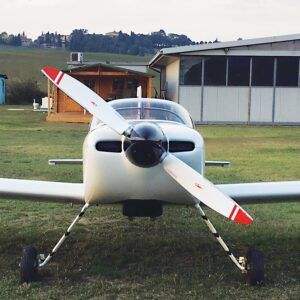
GT Propellers
Italian propeller maker GT Propellers’ website was shown as “under construction” late last year, but we were assured that they are still in business and delivering custom constant-speed propellers to the U.S. regularly. A “big change in management” was reported, and the company spokesperson said they would soon be testing new propellers for RV-series airplanes.
Hartzell Propeller, Inc.
With a 107-year history of propeller design, Hartzell Propeller, headquartered in Piqua, Ohio, primarily supplies constant-speed props with aluminum and carbon fiber blades. Its specialized propeller sales department focuses on a robust collection of propellers for kit airplane builders and Experimental aircraft owners.
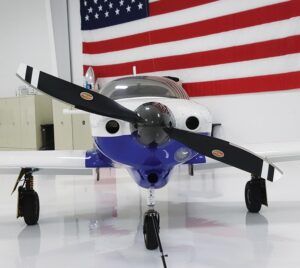
Released last year was Hartzell Manual 193, an information manual for Experimental aircraft, found on the company’s website.
In addition to Trailblazer and Pathfinder props for backcountry flying, Explorer propellers for cruising and Talon aerobatic props, Hartzell recently announced two-blade versions of its Blended Airfoil propellers, specifically for Van’s RV and Lancair 360 aircraft. As with the aluminum-blade BA propellers, these Carbon Blended Airfoil props feature swept-tip blades and Hartzell’s compact series hub. Hartzell Propeller continues to evolve its product line to support the homebuilt market.
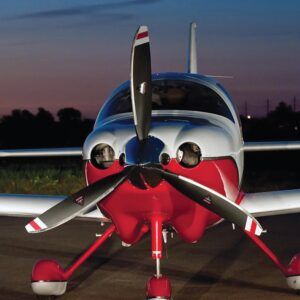
McCauley Propeller Systems
A subsidiary of Textron Aviation, McCauley celebrated its 85th anniversary in 2023 and supports 350,000 aircraft fitted with its props. Its Blackmac STC’d retrofit propellers are available for a wide range of airplanes and McCauley is standard equipment across the Textron new-plane fleet.
The latest approval was for a C780 four-blade swept aluminum propeller for the Beechcraft King Air 300 series.
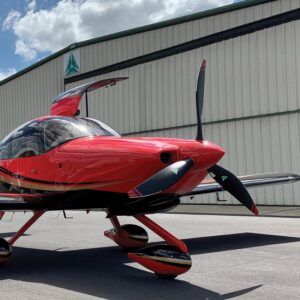
MT-Propeller USA, Inc.
Peter Marshall at MT-Propeller USA in DeLand, Florida, says its parent, MT-Propeller in Germany, is constantly pushing the limits of propeller technology.
Over its 40-plus years of existence, MT-Propeller has extended its line of natural-composite props over a wide range of aircraft, from small Experimentals to corporate turboprops.
Sensenich Propeller Company
Founded in 1932, Sensenich is unique among propeller manufacturers in producing metal, wood and composite props.
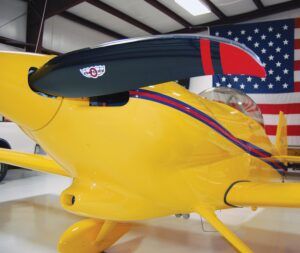
Now based in Plant City, Florida, where all production was consolidated in 2023, Sensenich targets the Experimental market with ground-adjustable carbon fiber STOL propellers. A new propeller approved for Lycoming O-320 powered Super Cubs was announced at AirVenture 2023, and company president Don Rowell said 120 of them had already been shipped when we spoke with him in November.
Non-Certified Propeller Suppliers
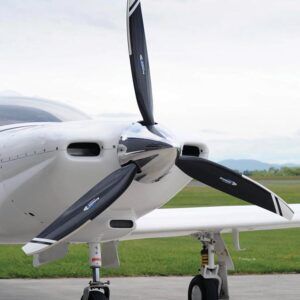
Airmaster Propellers, Ltd.
All is well with Airmaster Propellers in New Zealand—we are told numerous new products were in development, to be announced at AirVenture Oshkosh 2024. The company manufactures electric constant-speed propeller systems, using hubs holding up to five composite blades.
Visit their website for further information.
AXSport Aviation
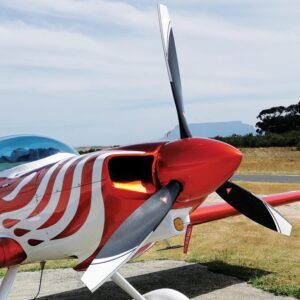
South African company AXSport Aviation makes three-blade constant-speed infused carbon fiber propellers, initially developed for its own Lycoming-powered AXSport aerobatic aircraft, which is currently being joined by a Rotax-powered Light Sport version. Going forward, a hydraulic constant-speed prop is under development to supplement the electric model. AXSport has recently doubled its production capacity, reducing lead time for propeller orders to eight weeks. The company takes pride in manufacturing all components—hubs, blades, spinners and controllers—in house.
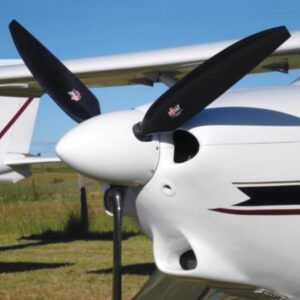
Bolly Aviation
Based in Virginia, South Australia, Bolly supplies ground-adjustable carbon-fiber propellers for LSA and ultralight aircraft in two-, three- and four-blade configurations. The Bolly Optima Series 5 props are designed for direct-drive applications and the Series 3 Optima propellers are fitted to engines with reduction drives.
Catto Propellers
Craig Catto has been building propellers for Experimental-category airplanes for 50 years, so his products have a popular following in the industry.
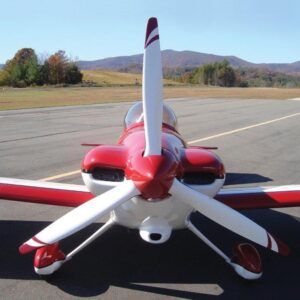
Incorporating a maple wood core with fiberglass and carbon fiber composite overlay, Catto has two- and three-blade fixed-pitch custom styles, along with a constant-speed prop for canard-type airplanes.
Last fall, we were given advance notice of Catto’s latest innovation, a ground-adjustable propeller tailored for Cub-style airplanes that was to be available by mid-December. It’s suitable for engines from the O-200 Continental to O-320/340/360 Lycomings. Look for further information soon. Catto Propellers is located in Jackson, California.
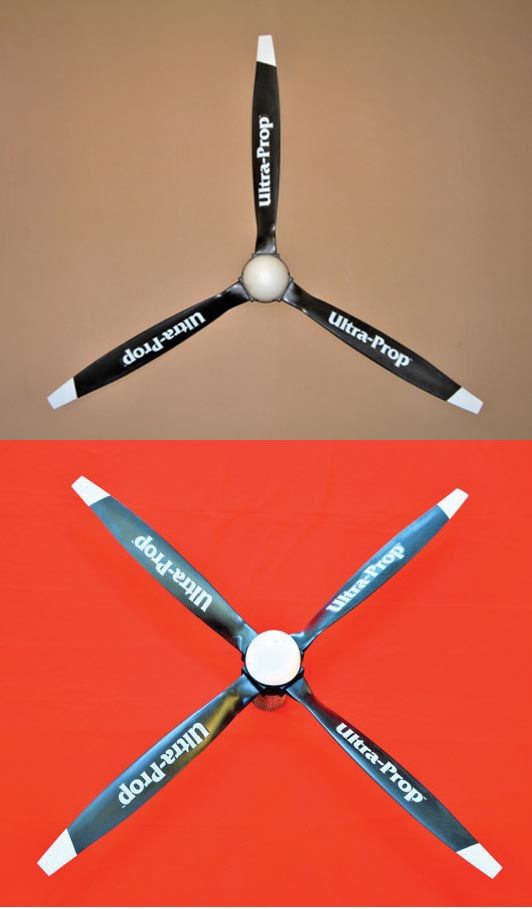
Competition Aircraft, Inc.
Designers of the Ultra-Prop series of composite-blade propellers, Competition Aircraft in Hurricane, Utah, has a 40-year track record of making low-cost adjustable-pitch props for trikes, gyrocopters and powered parachutes.
Its Ultra-Prop I was limited to 50-hp engines in four-blade configuration, but the beefier Ultra-Prop II can handle up to 25-hp per blade, with up to six-blade kits available.
Owner Bob Davis told us business has been good, but he’s considering selling the company to the right individual and retiring. So, if you’re interested, get in touch with him and see if it’s still available.
Culver Props
As is typical of custom propeller makers, Alaina Lewis in Rolla, Missouri, has a steady flow of orders coming in and was at a four- to five-month lead time when we spoke in late 2023. Her beautiful laminated-wood fixed-pitch props for antique replicas and homebuilts are in high demand. She mostly works on her own, saying “I can work faster by myself.” She produces decorative “wall hanger” and trophy propellers in addition to her airworthy products.
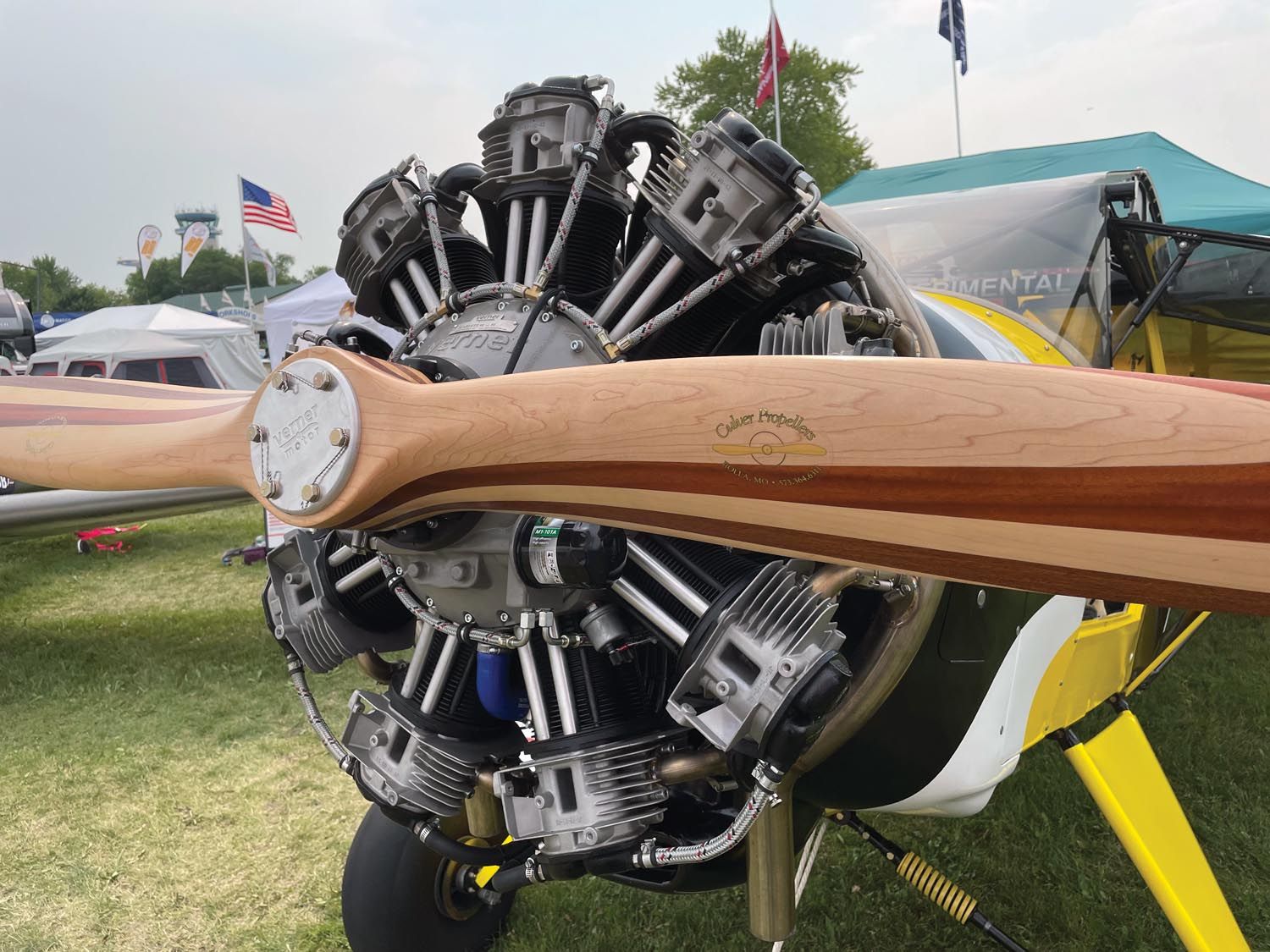
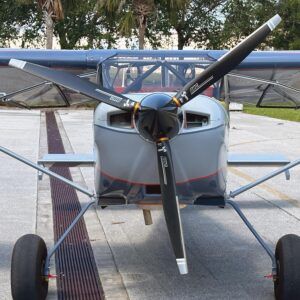
DUC Propellers USA
Represented by a subsidiary office in Sebring, Florida, French-made DUC Propellers have a strong following. Their defining feature is a proprietary Forced Carbon construction. In addition to the earlier Flash, Swirl, Windspoon and Flair propeller series, new for this year are Cobra ground-adjustable or variable-pitch carbon fiber props for direct-drive engines up to 315 hp and a Tiger variable-pitch propeller specifically for the Rotax 916. DUC props are available as ground-adjustable as well as hydraulic, electric or hybrid variable-pitch variants.
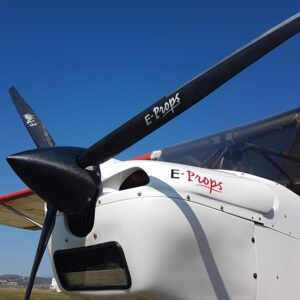
E-Props Propellers
Located in the southeast of France, E-Props has been supplying carbon composite propellers with titanium leading edges since 2008 and specializes in gear-drive Rotax engine installations. However, in 2024 it is expanding into propellers for Lycoming and Continental engines up to 300 hp. Making 45,000 blades per year, ASTM-certified E-Props are flying in 84 countries and still claim to be the “world’s lightest” propellers. The Rotax-targeted propeller weighs only 8.8 pounds. E-Props are distributed in the U.S. by Larry Mednick at Evolution Trikes, 813-810-9262.
GSC Systems, Ltd.
GSC Systems makes fine hard-rock maple propellers at its plant in Vernon, British Columbia, offering ground-adjustable and fixed-pitch styles in two- and three-blade configurations. They primarily serve the powered paraglider ultralight market, typically using Subaru, Jabiru and VW engines. GSC’s Tech series uses a light aluminum hub with individual blades for ease of transport and damaged blade replacement. They can custom-make and improve a duplicate made from an existing propeller, if required.
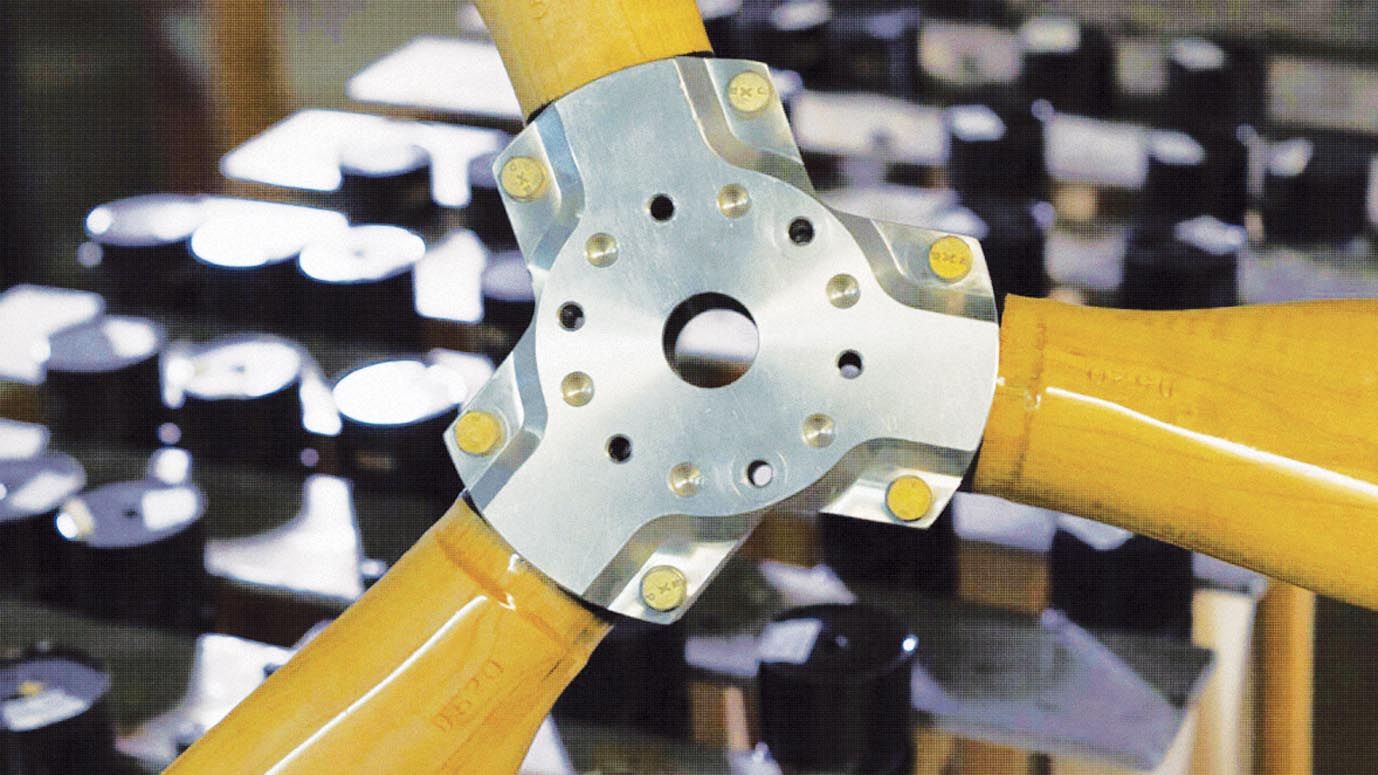
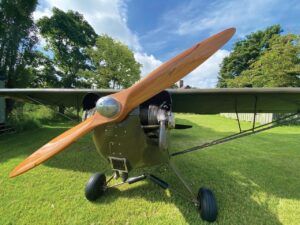
Hercules Propellers, Ltd.
Rubert Wasey, managing director with Hercules Propellers at Stroud in England, reports that they hold U.K. CAA approval for manufacturing propellers and are supplying fixed-pitch wooden props for the Experimental market, fitted with urethane leading-edge protection. Hercules is currently working on certification of propellers for the Piper Cub, Stinson 108 and Stearman aircraft. They even build replacement Rotol propellers for the Spitfire.
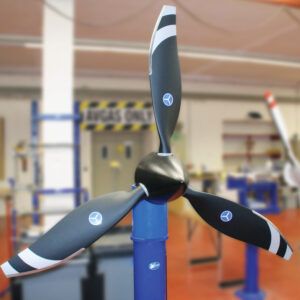
Hoffmann Propeller GmbH & Co. KG
Long-established German prop maker Hoffmann Propeller has been in business since 1955, building propellers for everything from dirigibles to gyrocopters. Guido Wolf, COO, states that the company is quite active in U.S. Experimental aircraft. It is developing a new lightweight ground-adjustable prop that may offer a variable-pitch feature, specifically designed for the Rotax 916 and other engines. Certification was expected by the end of 2023. Blades are built around a wooden core covered with epoxy composite; the props are fitted with nickel leading edges. The factory is at Rosenheim in Bavaria, southeastern Germany.
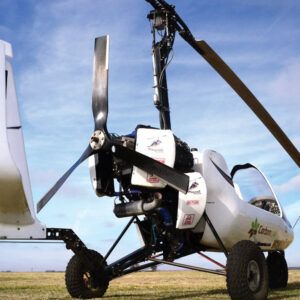
Ivoprop Corporation
It’s been 40 years since Ivo Zdarsky escaped from communist Czechoslovakia by flying across the border to Austria in a homebuilt trike. His company, Ivoprop, based in Long Beach, California, is still making carbon fiber propellers with unique adjustable embedded torque rods that allow pitch adjustment on the ground or in flight. Ivoprop’s Medium series is suitable for up to 150-hp applications, while the Magnum series is suitable for up to 700 hp.
KievProp America
Kiev Propellers, built in Ukraine, is represented in the Americas by Ted Bryant in Cambridge, Maryland. He says he’s getting steady shipments of orders every two or three weeks, with three composite propeller styles: ground-adjustable, in-flight adjustable with either hydraulic or electric control, and a three-position cable-actuated prop for takeoff, climb and cruise. Kiev propellers are designed for reduction-drive engines only, from 40 to 200 hp, in two- to six-blade hub types.
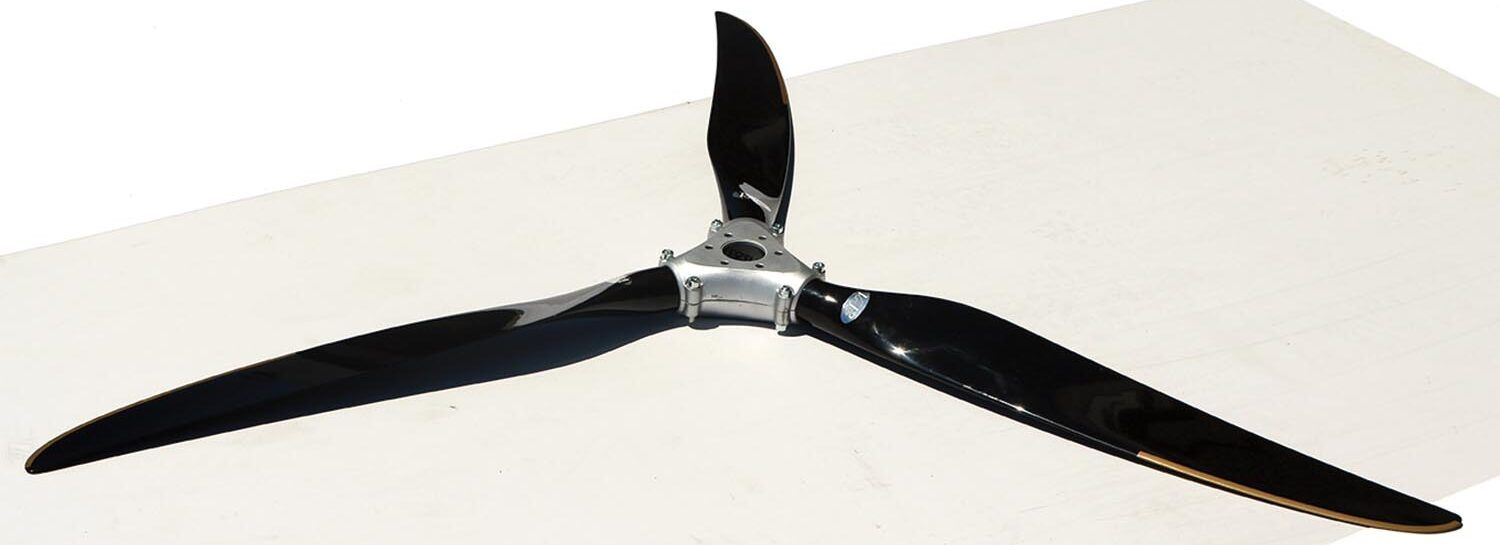
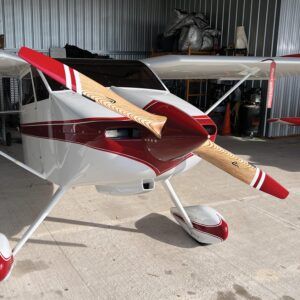
Performance Propeller, LLC
With a 35-year history of making fine laminated-wood propellers, suburban-Chicago based Performance Propeller’s lead time for custom-made two- and three-blade props is stretched out to a year or more, according to co-owner Dominic Flamini. Their propellers are designed to give good takeoff performance without compromising cruise speed. To get an early start on ordering a Performance Propeller prop, contact them via email through their website.
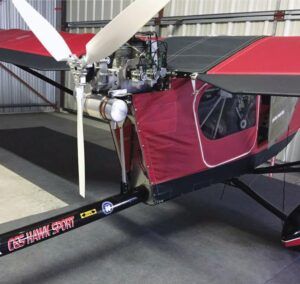
Powerfin Propellers
Based in Hurricane, Utah, Powerfin has been supplying its low-inertia prepreg carbon fiber propellers since 2008, primarily for ultralights, trikes and powered parachutes. Two- to five-blade hubs are offered, with blades in optional custom colors.
Powerfin propellers can handle up to 160-hp engines.
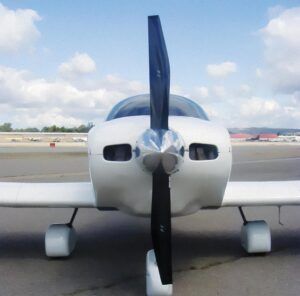
Prince Aircraft Company
Lonnie Prince’s wood/composite propellers have a loyal following in the custom prop industry, with a 45-year track record. He reported a 10-month backlog of orders when we visited in November 2023, so plan accordingly. The innovative P-Tip prop adds a winglet effect on the tip to boost effective diameter, and the scimitar-shape Prince propellers can twist with airspeed to alter their pitch up to 4 inches. Prince’s plant is located in Whitehouse, Ohio.
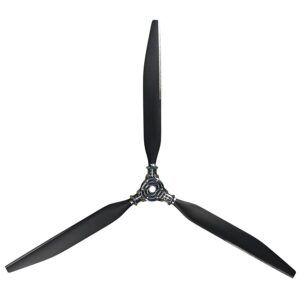
Warp Drive, Inc.
Based in Ventura, Iowa, Warp Drive builds ground-adjustable carbon fiber props for a variety of applications, from gyro/trike/PPC installations to Light Sport-size Experimental airplanes. Hub styles from two to six blades are available. A new four-blade hub was announced at Oshkosh last year. With 35 years of production experience, Warp Drive is consistently on the leading edge of sport aircraft propeller development.
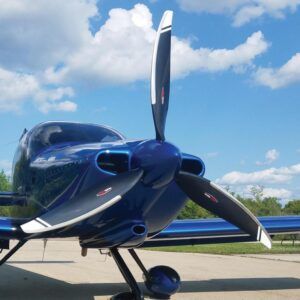
Whirl Wind Propellers Corporation
Jim Rust at Whirl Wind Propellers in El Cajon, California, shared with us some new blade designs and spinner options for their 300 and 330 propeller models, both featuring carbon fiber blades with nickel leading edges. The new 300 series is a 36-pound three-blade prop for RV-style aircraft with IO-320 to IO-390 engines, offering better takeoff and climb with no sacrifice of top speed. The 330 propeller is a scimitar-shape three-blade aerobatic prop weighing 58 pounds, giving excellent low-speed thrust for acrobatic and STOL performance. It is also available as a two-blade. New spinner and counterweight options are now available as well.
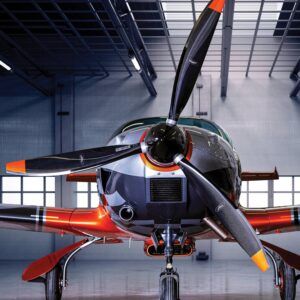
Woodcomp Propellers
Jiri Holoubek at Woodcomp Propellers in the Czech Republic says they are actively supplying wood/composite props to U.S. Experimental aircraft, chiefly those with Rotax 9-series engines, although he claims they can furnish propellers for Lycoming engines up to 350 hp. Their newest products are hydraulically controlled variable-pitch propellers for the Rotax 915 iS and 916 iS. Established in 2000, Woodcomp has certified props for Rotax engines up to 160 hp, as well as Lycomings.

